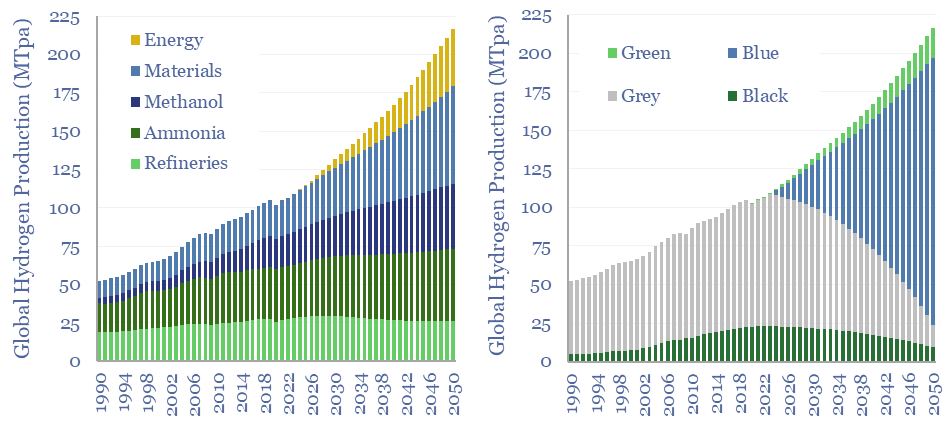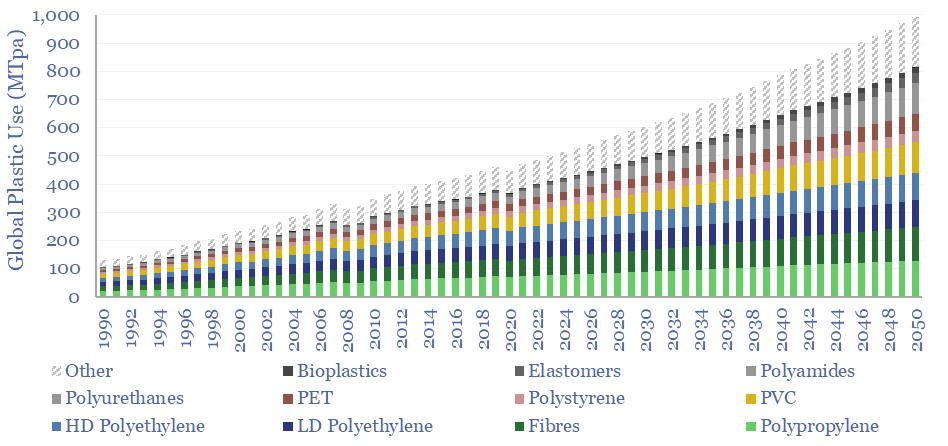Sulphur recovery units: Claus process economics?

…While we think a marginal price of $100/ton should incentivize new Claus units with a 10% IRR. This is assuming H2S inputs are effectively free, as sourced from hydroprocessing or…

…While we think a marginal price of $100/ton should incentivize new Claus units with a 10% IRR. This is assuming H2S inputs are effectively free, as sourced from hydroprocessing or…

…some geographies. Refineries use 25-30% of the world’s hydrogen, mainly for hydroprocessing. While oil demand is flatlining in some geographies and declining in others (pages 10-11). Hence our hydrogen outlook…

…into oil production, gas production, gas fractionation to ethane, ethane cracking to ethylene, oil refining to naphtha, naphtha cracking to PX, PX oxidation to PTA, make-up methanol solvent, PET production,…

…per ton of polyethylene. This matters as the world consumes c140MTpa of PE, 30% of the global plastics market, whose cracking and polymerisation emits 1.6T of CO2 per ton of…

…are all familiar (more so than, say, ethane cracking, below). https://thundersaidenergy.com/downloads/ethane-cracking-the-economics/ Ideally you will also come away from this article with some interesting insights for the next time you are…

…point, our ethane cracker model is linked here, and our economic model for converting olefins into polymers is here. CO2 intensity of different plastics from different facilities is tabulated here….

…there is no commercially available electric alternative to an ethane cracker, although some interesting concepts are at early stages of technical readiness. Electrification of the glass industry is discussed on…

…plastics closer to $1-1.5/kg. What are the capex costs of producing bioplastics? We would typically assume $1,300/Tpa for an ethane cracker, $1,500/Tpa for an integrated crude to chemicals plant, but…

…A single commodity chemical facility often supports 20 downstream processes. While a naphtha cracker produces seven main petrochemical feedstocks, and offtakers must be found for all seven. To illustrate the…

…source, and there are also practical ways of blending gas back-ups with renewables in fully decarbonized power grids (notes below). https://thundersaidenergy.com/2021/10/21/carbon-capture-how-big-is-the-opportunity/ https://thundersaidenergy.com/2020/09/24/deep-blue-cracking-the-code-of-carbon-capture/ https://thundersaidenergy.com/2021/11/04/small-scale-ccs-transport-liquid-co2/ https://thundersaidenergy.com/2021/09/02/integrated-energy-a-new-model/ https://thundersaidenergy.com/2022/08/18/scope-4-emissions-avoided-co2-has-value/ (4) What about the costs?…